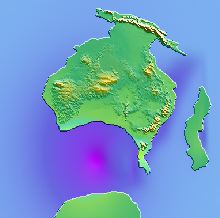10 June 1998
Ups And Downs Down Under
 Like a giant version of Rolph Harris' wobble board, the Australian continent is flexing hundreds of metres up and down, say scientists at the Commonwealth Scientific and Industrial Research Organization (CSIRO) and Caltech. Their research, published in the latest issue of Science, offers revolutionary new insights into the movement of the Earth's outer crust, and has been hailed as a breakthrough in the art of mapping vast geological events.
Like a giant version of Rolph Harris' wobble board, the Australian continent is flexing hundreds of metres up and down, say scientists at the Commonwealth Scientific and Industrial Research Organization (CSIRO) and Caltech. Their research, published in the latest issue of Science, offers revolutionary new insights into the movement of the Earth's outer crust, and has been hailed as a breakthrough in the art of mapping vast geological events.
The findings have also solved one of geology's most intriguing puzzles. For years scientists have been confounded by the anarchic, topsy-turvy disposition of the Land Down Under. Why, they wondered, were large parts of Australia's interior flooded when global sea levels were low? And why did the inland sea then dry up when sea levels rose again?
"The answer is that we are literally living on the scum of the earth," says CSIRO's Louis Moresi with an unfortunate turn of phrase. "The continents are composed of a thin crust of the lightest rocky material, and they both drift and bob up-and-down in response to the stirrings of enormous convective currents driven by radioactive decay in the Earth's mantle below them."
Using a sophisticated 3D computer model, the researchers have created a spectacular full-colour movie of Australia's tectonic movement, spanning more than 100 million years in just a few minutes. It shows how the continent broke free of Antarctica to head north, and how its inundated eastern half wobbled vertically upward, draining the Jurassic seas from its surface. "This work opens up a huge new frontier in which the motions of plates can be predicted from computer models of the Earth's internal heat engine, in much the same way as scientists use similar models to study climate change," says Michael Gurnis of Caltech.
Pic Courtesy CSIRO
GoGo Further: Cool Animated Graphics at CSIRO
